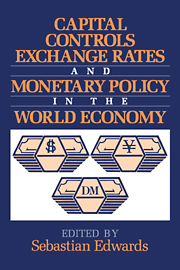Book contents
- Frontmatter
- Contents
- List of contributors
- Introduction
- Part I Monetary policy and stabilization in open economies
- Part II Capital mobility and macroeconomic policy in Europe
- Part III Capital controls and macroeconomic policy in the Asia-Pacific region
- 8 Capital movements, real asset speculation, and macroeconomic adjustment in Korea
- 9 The determinants of capital controls and their effects on trade balance during the period of capital market liberalization in Japan
- 10 Capital mobility and economic policy
- 11 Monetary and exchange rate policies 1973–1991: the Australian and New Zealand experience
- Part IV Capital mobility and exchange rates in Latin America
- Index
9 - The determinants of capital controls and their effects on trade balance during the period of capital market liberalization in Japan
Published online by Cambridge University Press: 16 October 2009
- Frontmatter
- Contents
- List of contributors
- Introduction
- Part I Monetary policy and stabilization in open economies
- Part II Capital mobility and macroeconomic policy in Europe
- Part III Capital controls and macroeconomic policy in the Asia-Pacific region
- 8 Capital movements, real asset speculation, and macroeconomic adjustment in Korea
- 9 The determinants of capital controls and their effects on trade balance during the period of capital market liberalization in Japan
- 10 Capital mobility and economic policy
- 11 Monetary and exchange rate policies 1973–1991: the Australian and New Zealand experience
- Part IV Capital mobility and exchange rates in Latin America
- Index
Summary
Introduction
The purpose of this essay is to investigate the determinants of capital controls and their effects on trade balance during the period of capital market liberalization in Japan. As is well known, the capital market in Japan was gradually liberalized in the 1970s. However, the liberalization was sometimes accompanied by the introduction of other capital controls. This chapter examines how these capital controls were liberalized and what distributional effects they had on the trade balance during the period of capital market liberalization in Japan.
In the analysis, we measure the degree of capital liberalization by deviations from covered interest rate parity. If the capital market is perfectly liberalized, this covered interest rate parity must always hold. In fact, after December 1980 (the year of the enactment of the new Foreign Exchange and Foreign Trade Control Law in Japan), deviations from covered interest rate parity became negligible in Japan. However, deviations were very significant for several periods in the 1970s. Thus, we can approximately measure the degree of Japanese capital controls by using these deviations in the 1970s.
Several empirical studies have investigated the determinants of Japanese capital controls in the 1970s (e.g., Ueda and Fujii 1986, Fukao 1990, Komiya and Suda 1991). This essay first reconfirms the results of these previous studies, which propose that the degree of capital controls in Japan was determined by the excess deficit and surplus in trade balance in the 1970s.
- Type
- Chapter
- Information
- Publisher: Cambridge University PressPrint publication year: 1995



